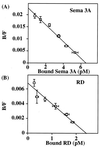Semaphorin 3A growth cone collapse requires a sequence homologous to tarantula hanatoxin
- PMID: 10557350
- PMCID: PMC23977
- DOI: 10.1073/pnas.96.23.13501
Semaphorin 3A growth cone collapse requires a sequence homologous to tarantula hanatoxin
Abstract
Axonal guidance is key to the formation of neuronal circuitry. Semaphorin 3A (Sema 3A; previously known as semaphorin III, semaphorin D, and collapsin-1), a secreted subtype of the semaphorin family, is an important axonal guidance molecule in vitro and in vivo. The molecular mechanisms of the repellent activity of semaphorins are, however, poorly understood. We have now found that the secreted semaphorins contain a short sequence of high homology to hanatoxin, a tarantula K(+) and Ca(2+) ion channel blocker. Point mutations in the hanatoxin-like sequence of Sema 3A reduce its capacity to repel embryonic dorsal root ganglion axons. Sema 3A growth cone collapse activity is inhibited by hanatoxin, general Ca(2+) channel blockers, a reduction in extracellular or intracellular Ca(2+), and a calmodulin inhibitor, but not by K(+) channel blockers. Our data support an important role for Ca(2+) in mediating the Sema 3A response and suggest that Sema 3A may produce its effects by causing the opening of Ca(2+) channels.
Figures




References
-
- Mark M D, Lohrum M, Puschel A W. Cell Tissue Res. 1997;290:299–306. - PubMed
-
- Luo Y, Raible D, Raper J A. Cell. 1993;75:217–227. - PubMed
-
- Kolodkin A L, Matthes D J, Goodman C S. Cell. 1993;75:1389–1399. - PubMed
-
- Behar O, Golden J A, Mashimo H, Schoen F J, Fishman M C. Nature (London) 1996;383:525–528. - PubMed
-
- Taniguchi M, Yuasa S, Fujisawa H, Naruse I, Saga S, Mishina M, Yagi T. Neuron. 1997;19:519–530. - PubMed
Publication types
MeSH terms
Substances
Grants and funding
LinkOut - more resources
Full Text Sources
Other Literature Sources
Molecular Biology Databases
Miscellaneous

